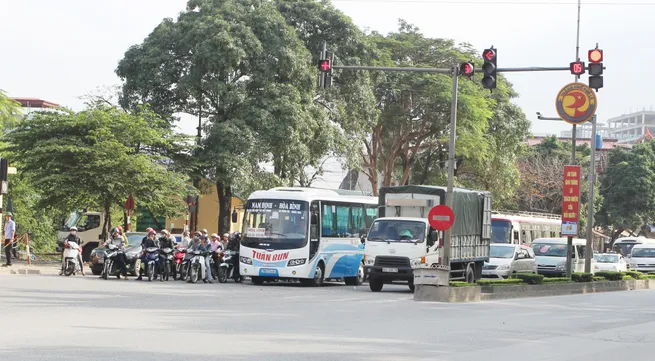Efforts exerted to build a synchronous and safe traffic system

Compared to the same period last year, the number of accidents, fatalities and injured, went down 7.3 percent, 10.4 percent and 17.4 percent, respectively. Among them, 214 road accidents left 120 dead and 137 injured, while two railway accidents killed one and injured another.
The fact that the number of traffic accidents, the number of dead or injured people has decreased significantly, is thanks to the participation of the whole political system, with the determination to reduce traffic accidents in a sustainable way, towards building a society with a safe, smooth and convenient traffic systems, while road users consciously obey the law on traffic order and safety, to form a safe traffic culture.
In order to continue promoting the above spirit, the Ministry of Public Security and the Ministry of Transport, have recently studied and proposed to the Government, law projects to further improve the entire transport system throughout the country.
The Ministry of Public Security has reported to the Government, on the need to separate the Road Traffic Law into two laws: the Road Law and the Law on Road Traffic Order and Safety. Accordingly, after more than 13 years of implementation of the Law on Road Traffic in 2008, many shortcomings and limitations have arisen, which are no longer suitable with the actual current situation.
Specifically, traffic safety issues, transport infrastructure and road transport, are very large areas, with different objectives and subjects of regulation, but they are all regulated under the same law, leading to the fact that it is impossible to fully, specifically and clearly prescribe many important contents, in each field.
The Law on Road Traffic in 2008 does not fully and specifically stipulate the relevant regulations to ensure traffic order and safety that needs to be supplemented, such as: traffic accident settlement, traffic command and control, dealing with traffic jams and security, order and events on traffic routes, including law enforcement on traffic order and safety.
Besides the situation of blatantly violating and disregarding the law while on the road remains common, the traffic culture is still weak, mixed and unsafe traffic is still an obsession for many people, affecting economic development, foreign investment attraction, and social security.
Crimes related to road traffic are very complicated, while the 2008 Road Traffic Law does not have specific regulations on vehicle development, to ensure synchronisation with the development of transport infrastructure and the socio-economic condition of Vietnam.
Through learning from international experiences, the Ministry of Public Security found that no country has enacted a road traffic law, covering all three areas of traffic safety, infrastructure and road transport. They are separate from each other to facilitate the State management.
Although the Ministry of Public Security has pointed out many urgent reasons to separate the law, there are still some concerns that it should not be split into two laws, because in reality, if separated into two laws, the Road Traffic Law will not cover all road issues. Similarly, the Law on Road Traffic Order and Safety does not guarantee the content of this law.
According to a representative of the Traffic Police Department, under the Ministry of Public Security, in the current new situation, the separation of laws is inevitable. The Law on Traffic Order and Safety revolves around the goal of ensuring safety for road users, specialising in traffic safety-related factors such as: people, vehicles and traffic rules, etc. Meanwhile, the Road Traffic Law has the basic objective of developing a complete road system, with adequate institutions that meet the requirements of road planning, investment and development.
In addition, an issue when separating the law that caused many mixed opinions was: the content of transferring state management functions and training, testing, and issuing driver's licenses from the Ministry of Transport to the Ministry of Public Security. The view from many local Departments of Transport, as well as the Vietnam Automobile Transport Association, believe that this function should not be transferred from the Ministry of Transport to the Ministry of Public Security.
Because, drivers' licenses in Vietnam are now recognised by many countries around the world and Vietnam has also issued an international driving license. The change of drivers' licenses has also pioneered the implementation of a level four public service, that is highly appreciated by the people. In addition, in most countries around the world today, the training and testing for the issuance of drivers' licenses are under civilian management.
However, according to the Ministry of Public Security, the draft submitted by the Ministry of Public Security to the Government, does not build a separate driver training and testing system, but identifies stronger socialisation of this activity. Determining that driver training and testing is a conditional business line, according to the provisions of the investment law, and the state does not interfere in the business activities of training institutions. In case the National Assembly passes and promulgates a law, it is the Government's authority to assign which ministry will manage driver training and testing.
Faced with the above facts, the Ministry of Public Security and the Ministry of Transport, need to carefully continue considering the contents, to reach a consensus in the process of developing the draft law. All while strengthening and clarifying the factors affecting the necessity to separate the law and strengthen the information dissemination on new contents in the draft law, for people to grasp and comment on.
In addition, it is necessary to ensure that when the law is promulgated, it must be easy to understand and enforce, both ensuring traffic safety and creating breakthroughs and improvements in administrative procedures, as well as creating a modern transport system, with smart utilities convenient for all people.
Tags:





